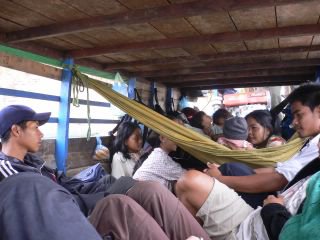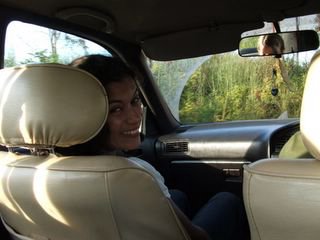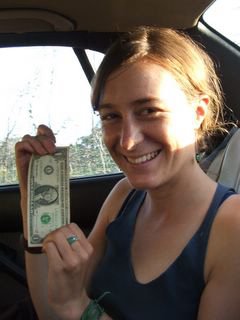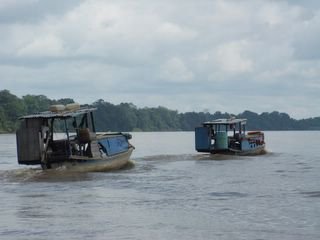Part 4 (The Horror)
I awake to find myself in a little wooden hut in Ban Lung, the provincial capital of Ratanikiri. We are staying at a lovely guesthouse located on a hillside in a lushly forested area. I savour the feeling of slowly getting out of bed and not having to rush off onto any form of transport. After a leisurely breakfast we hire push-bikes and tackle the muddy, boggy road into town.

The centre of town features an independence monument which appears to be the favourite hangout for the towns goats. There are very few sealed roads and the phrase “dust bowl” comes to mind. We visit the local market which has a commanding presence in the centre of town. It is a huge cement building with modern architectural lines; older than its years, the dust and heat hastening its senescence.

After the market we visit the Virachay National Park Head Office to arrange a visit to the park. We had talked with the rangers at the office in Vern Sai but due to logistical problems had decided not to enter the park at that point (see The Horror Part 2). The National Park Officer who we spoke to in Ban Lung was helpful and informative. We left the office with plans in place, and a collection of hired hiking gear for our trip. On our way back to our guesthouse we drop into Yak Lom Lake. The lake was formed by a volcanic eruption almost 4,000 years ago and is now a popular spot for picnics and walks. I don my pants and singlet top over my bikini and dive into the cool, fresh water. After a short time, the sun begins to set in the sky. Despite the fact that we hadn’t battled with any public transport operator it has been a long day. We wearily work our way up hill on our bikes and back to our little huts.
Ban Lung to Vern Sai
Journey: 1.5 hours by moto
Road condition: extremely muddy
It was before 7am that we experience our first misadventure for the day. We had arranged for the Yak Lom Lodge landcruiser to drive us into town so to catch a lorry to Voen Sai. In a typical display of Khmer “can do” attitude the driver of the landcruiser did not wait and give way to a large truck stopped in a particularly muddy quagmire of the road and instead persisted forwards. Thirty seconds later the back left-hand-side windshield explodes inwards and the landcruiser is pinioned helplessly between the truck and the thick forest lining the road.
After some maneuvering we manage to free both ourselves and the car and make it into town. We arrive at the taxi/truck stand to discover that the 7.30am truck from Voen Sai simply has not arrived this morning. Our options are to wait for the afternoon truck or pay $30 usd for a taxi. As we are digesting this piece of news our taxi driver from our Stung Treng stint materialises and kindly offers to take us for the nominated fee. We stand around and make statements like “oooh, tly peck” (too expensive). The Vern Sai taxi dudes show some initial interest but then pay us little heed once it becomes obvious we aren’t going to pay $30 USD to travel 38km.
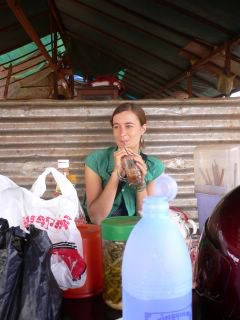
After an ice coffee and 20 minutes of indecision we make arrangements to take motos to Voen Sai. In true style, the inner workings of the moto-mob mean that the moto drivers that we negotiated our fare with are not the moto-dudes we travel with. At this point I am past caring. We clamber onto our allotted motos and speed off. It is a beautiful and scenic drive, and perhaps better appreciated when on the back of a moto anyway!
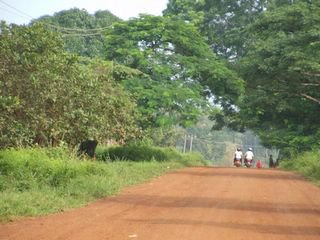
We spend a nice afternoon in Voen Sai. We set up camp at the Virachay National Park Headquarters and then set off to explore the local area. We hire a noisy fast boat and speed along the Tonle Se San river to visit a Tumpuan village and cemetery. The Tumpuans are a semi-nomadic, animist minority group that live in north-eastern Cambodia.
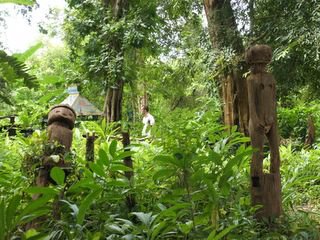
We clamber out of our boat and are escorted through the village to their cemetery. I feel a little uncomfortable about fronting up like this and our two self-appointed guides do little to assuage this as they silently and sternly lead us into thick forest dotted with wooden carved figures and small, colourful shelters.

After time passes, we chat in Khmer a little about the cemetery and the village, slowly our escort becomes more friendly. The graves are comprised of a small wooden shelter with food, incense and gifts inside. In front of this is generally a carved wooden representation of the deceased, brightly painted.

At one of the graves we come across a wooden man with metal sun glasses and a wooden walkie talkie. We find this amusing until our guide informs me that this is the grave of the village chief and that he was a highly respected man.

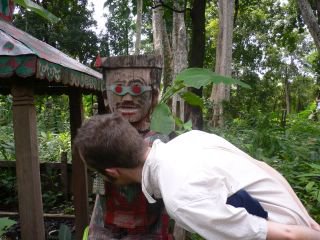
Andrew paving his way to animist hell...
Our next stop is two Laotian and Chinese villages further upstream. We wander about aimlessly and then head back to Voen Sai. We are going to spend the night in our hammocks strung up underneath the National Park Head Office. The aim is to get up bright and early the next morning and start our trek to the National Park with our guide. The park headquarters are quite cosy. The building is a large, breezy wooden Khmer style house with a large dirt space underneath. Krishni and I pull on our sarongs and head down to the river for our evening bath. We sit on an overturned boat in the water soaping ourselves, washing our clothes and chatting. I am feeling cool, clean and relaxed.

The centre of town features an independence monument which appears to be the favourite hangout for the towns goats. There are very few sealed roads and the phrase “dust bowl” comes to mind. We visit the local market which has a commanding presence in the centre of town. It is a huge cement building with modern architectural lines; older than its years, the dust and heat hastening its senescence.

After the market we visit the Virachay National Park Head Office to arrange a visit to the park. We had talked with the rangers at the office in Vern Sai but due to logistical problems had decided not to enter the park at that point (see The Horror Part 2). The National Park Officer who we spoke to in Ban Lung was helpful and informative. We left the office with plans in place, and a collection of hired hiking gear for our trip. On our way back to our guesthouse we drop into Yak Lom Lake. The lake was formed by a volcanic eruption almost 4,000 years ago and is now a popular spot for picnics and walks. I don my pants and singlet top over my bikini and dive into the cool, fresh water. After a short time, the sun begins to set in the sky. Despite the fact that we hadn’t battled with any public transport operator it has been a long day. We wearily work our way up hill on our bikes and back to our little huts.
Ban Lung to Vern Sai
Journey: 1.5 hours by moto
Road condition: extremely muddy
It was before 7am that we experience our first misadventure for the day. We had arranged for the Yak Lom Lodge landcruiser to drive us into town so to catch a lorry to Voen Sai. In a typical display of Khmer “can do” attitude the driver of the landcruiser did not wait and give way to a large truck stopped in a particularly muddy quagmire of the road and instead persisted forwards. Thirty seconds later the back left-hand-side windshield explodes inwards and the landcruiser is pinioned helplessly between the truck and the thick forest lining the road.
After some maneuvering we manage to free both ourselves and the car and make it into town. We arrive at the taxi/truck stand to discover that the 7.30am truck from Voen Sai simply has not arrived this morning. Our options are to wait for the afternoon truck or pay $30 usd for a taxi. As we are digesting this piece of news our taxi driver from our Stung Treng stint materialises and kindly offers to take us for the nominated fee. We stand around and make statements like “oooh, tly peck” (too expensive). The Vern Sai taxi dudes show some initial interest but then pay us little heed once it becomes obvious we aren’t going to pay $30 USD to travel 38km.

After an ice coffee and 20 minutes of indecision we make arrangements to take motos to Voen Sai. In true style, the inner workings of the moto-mob mean that the moto drivers that we negotiated our fare with are not the moto-dudes we travel with. At this point I am past caring. We clamber onto our allotted motos and speed off. It is a beautiful and scenic drive, and perhaps better appreciated when on the back of a moto anyway!

We spend a nice afternoon in Voen Sai. We set up camp at the Virachay National Park Headquarters and then set off to explore the local area. We hire a noisy fast boat and speed along the Tonle Se San river to visit a Tumpuan village and cemetery. The Tumpuans are a semi-nomadic, animist minority group that live in north-eastern Cambodia.

We clamber out of our boat and are escorted through the village to their cemetery. I feel a little uncomfortable about fronting up like this and our two self-appointed guides do little to assuage this as they silently and sternly lead us into thick forest dotted with wooden carved figures and small, colourful shelters.

After time passes, we chat in Khmer a little about the cemetery and the village, slowly our escort becomes more friendly. The graves are comprised of a small wooden shelter with food, incense and gifts inside. In front of this is generally a carved wooden representation of the deceased, brightly painted.

At one of the graves we come across a wooden man with metal sun glasses and a wooden walkie talkie. We find this amusing until our guide informs me that this is the grave of the village chief and that he was a highly respected man.


Andrew paving his way to animist hell...
Our next stop is two Laotian and Chinese villages further upstream. We wander about aimlessly and then head back to Voen Sai. We are going to spend the night in our hammocks strung up underneath the National Park Head Office. The aim is to get up bright and early the next morning and start our trek to the National Park with our guide. The park headquarters are quite cosy. The building is a large, breezy wooden Khmer style house with a large dirt space underneath. Krishni and I pull on our sarongs and head down to the river for our evening bath. We sit on an overturned boat in the water soaping ourselves, washing our clothes and chatting. I am feeling cool, clean and relaxed.
